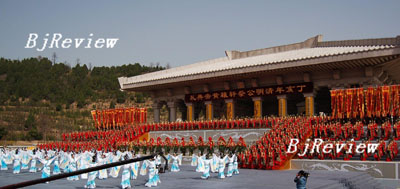|
 |
|
RITUAL PERFORMANCE: China's Shaanxi Province commemorates the Yellow Emperor, in a ceremony attended by around 10,000 people (JING XIAOLEI) |
April 5 was an extraordinary day in northwest China's Shaanxi Province. Around 10,000 people gathered in Huangling County to commemorate the Yellow Emperor, or Huang Di, the legendary ruler and ancestor of the Chinese nation. At a time when China is modernizing at a rapid pace, it marked a growing trend for observing old traditions that had been almost forgotten.
The Yellow Emperor, who lived more than 4,000 years ago, is also said to be the inventor of the principles of traditional Chinese medicine.
The gathering to pay respect to the Yellow Emperor took place at the Palace of Offering Sacrifices of the Mausoleum of the Yellow Emperor in Huangling County, where legend has it that the Yellow Emperor is buried.
It marked the Qingming Festival, a time when Chinese people traditionally honored their deceased ancestors.
A large drum was struck 34 times to represent the provinces, municipalities, autonomous regions, and special administrative regions of China. A bell was then rung nine times, the number representing the highest level of respect in traditional Chinese culture. More than 1,000 performers staged a four-part music and dance performance.
"I think it's necessary to have this big event to commemorate the Yellow Emperor, after all he is our ancestor and he deserves the Chinese people's respect," Dang Chen, 30, a dancer from Shaanxi who performed at the ritual, told Beijing Review.
Among the crowd there were more than 2,300 people from Hong Kong, Macao and Taiwan, who also bowed to the statue of the Yellow Emperor to pay their respect.
"Since childhood the history books have told us that we are the offspring of the Yellow Emperor and I'm so glad to be here to commemorate him on behalf of the Taiwan compatriots," said Hsieh Chi-ta, former chief of Taiwan's New Party.
According to legend, the Yellow Emperor won a decisive battle against the eastern Yan Emperor or Yan Di. The latter was the focus of a ritual that 10,000 people attended in his alleged burial place in Yanling County, Zhuzhou, in central China's Hunan Province on this memorial festival.
On the same day, a memorial ceremony for Confucius, the great thinker and educator of ancient China, was held in his hometown of Qufu in east China's Shandong Province.
The three events are among eight grand rituals included on the National Intangible Cultural Heritage List, which was announced by the State Council in May 2006. The list contains 518 items in 10 categories, including folk literature, traditional medicine and folk custom.
According to UNESCO, "intangible cultural heritage" refers to practices, representations, expressions, knowledge and skills that communities, groups and, in some cases, individuals recognize as part of their cultural heritage.
"Traditional festivals embody the cultural identity of a nation. The rituals to honor the Yellow Emperor and other ancestors will certainly help enhance unification and integrity among all the Chinese people," said Zhang Qizhi, a well-known Chinese scholar and Honorary President of China's Northwest University, who was at the grand ceremony to commemorate the Yellow Emperor.
"Ancient China was characterized by various rituals and ceremonies, which were considered as superstitious behaviors in China's modern history and therefore were overlooked for a time," said Wang Dasan, an independent scholar. "But in recent years as China sees a revival of its traditional culture, these rituals are again coming into the spotlight."
Honoring the Yellow Emperor and other ancient Chinese festivals is likely to continue to grow in popularity as Chinese people reconnect with their history, according to Zhang. But ancient festivals should be about more than formality and spending money, he cautioned. The core of these ancient rituals is recognition and respect from the bottom of people's hearts, he said. | 